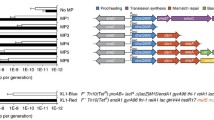Abstract
For studies on molecular mechanisms of mutagenesis, it would be advantageous to transfer mutant genes with specific alterations into mammalian cells and use the transformed cells in reversion analyses. In the present paper, we describe an efficient method for analyzing reversion events occurring in cells that possess multiple copies of a mutational target gene. This method involves amplification of the chromosomally integrated target genes with the polymerase chain reaction (PCR) and restriction endonuclease digestion of the amplified product. Single reversion events that either create or destroy restriction endonuclease recognition sequences that encompass the site of the original mutation can be identified in a background of 10–20 copies of the gene that retain the mutant sequence. Using this method, we have analyzed revertants induced by 5-bromodeoxyuridine (BrdU) in a Chinese hamster ovary cell line that possesses multiple copies of a mutant bacterial gpt gene containing a specific alteration. The results of this study not only demonstrate the effectiveness of this method for analyzing reversion of a single gene copy in transfectants possessing multiple copies of a mutant target gene, but also demonstrate that the sequence specificity for BrdU-induced mutations is the same in Chinese hamster cells as previously observed with mouse cells.
Similar content being viewed by others
Literature cited
Ashman, C.R., and Davidson, R.L. (1984).Mol. Cell. Biol. 42266–2272.
Ashman, C.R., Jagadeeswaran, P., and Davidson, R.L. (1986).Proc. Natl. Acad. Sci. U.S.A. 833356–3360.
Hauser, J., Seidman, M.M., Sidur, K., and Dixon, K. (1986).Mol. Cell. Biol. 6277–285.
Lebkowski, J.S., Miller, J.H., and Calos, M.P. (1986).Mol. Cell. Biol. 61838–1842.
DuBridge, R.B., Jang, P., Hsia, H.C., Leong, P.M., Miller, J.H., and Calos, M.P. (1987).Mol. Cell. Biol. 7379–387.
Ashman, C.R., and Davidson, R.L. (1987).Proc. Natl. Acad. Sci. U.S.A. 843354–3358.
Ashman, C.R., and Davidson, R.L. (1987).Somat. Cell Mol. Genet. 13563–568.
Davidson, R.L., and Ashman, C.R. (1987).Somat. Cell Mol. Genet. 13415–417.
Davidson, R.L., Broeker, P., and Ashman, C.R. (1988).Proc. Natl. Acad. Sci. U.S.A. 854406–4410.
Gelbert, L.M., and Davidson, R.L. (1988).Proc. Natl. Acad. Sci. U.S.A. 859143–9147.
Gelbert, L.M., Wilson, M.M., and Davidson, R.L. (1990).Somat. Cell Mol. Genet. 16173–184.
Kresnak, M.T., and Davidson, R.L. (1991).Somat. Cell Mol. Genet. 17399–410.
Kresnak, M.T., and Davidson, R.L. (1992).Proc. Natl. Acad. Sci. U.S.A. (in press).
Davidson, R.L., and Gerald, P.S. (1976).Somat. Cell Genet. 2165–176.
Hirt, B. (1967).J. Mol. Biol. 26365–369.
Hanahan, D. (1983).J. Mol. Biol. 166557–580.
Sambrook, J., Fritsch, E.F., and Maniatis, T. (1989).Molecular Cloning: A Laboratory Manual (Cold Spring Harbor Laboratory, Cold Spring Harbor, New York).
Engelke, D.R., Hoener, P.A., and Collins, F.S. (1988).Proc. Natl. Acad. Sci. U.S.A. 85544–548.
Innis, M.A., Myambo, K.B., Gelfand, D.H., and Brow, M.A.D. (1988).Proc. Natl. Acad. Sci. U.S.A. 859436–9440.
Mihovilovic, M., and Lee, J.E. (1989).Biotechniques 714–16.
Winship, P.R. (1989).Nucleic Acids Res. 171266.
Skopek, T.R., and Hutchinson, F. (1982).J. Mol. Biol. 15919–33.
Lasken, R.S., and Goodman, M.F. (1985).Proc. Natl. Acad. Sci. U.S.A. 821301–1305.
Muller, M., Martial, J., and Verly, W.G. (1988).J. Biochem. 253637–643.
Author information
Authors and Affiliations
Rights and permissions
About this article
Cite this article
Rotstein, J.B., Kresnak, M.T., Samadashwily, G.M. et al. Analysis of sequence specificity of 5-bromodeoxyuridine-induced reversion in cells containing multiple copies of a mutantgpt gene. Somat Cell Mol Genet 18, 179–188 (1992). https://doi.org/10.1007/BF01233163
Received:
Issue Date:
DOI: https://doi.org/10.1007/BF01233163




